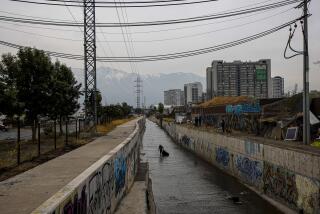A Timeless Land of Mist and Myth Off Chile’s Coast
- Share via
ACHAO, Chile — Like the mystical culture of the Chiloe archipelago itself, the church in this fishing hamlet has survived tempests, earthquakes and the inexorable assault of time.
The Santa Maria de Loreto church was built in 1730 by the master carpenters and boat makers of these rain-swept islands. The creaky interior has a nautical air; the curved ceiling resembles an inverted hull. The church once doubled as a lighthouse, overlooking a sea whose deadly rages are blamed on demons and monsters.
“The churches are always close to the water to guide our sailors, to give them hope,” said Bernardita Oyarzun, a village leader here on the small island of Quinchao.
Last month, Chile’s president and United Nations officials traveled to this structure that Oyarzun has tended so diligently and announced the designation of 14 churches as world cultural treasures. More than musty religious relics, the churches are outposts of a singular 400-year-old way of life, a mix of Spanish and indigenous cultures, of profound Roman Catholicism and vivid mythology.
The honor bestowed by UNESCO was rare. Chile’s only other U.N.-designated cultural heritage site encompasses the stone heads of far-off Easter Island. Chileans and especially Chilotes, as the 130,000 islanders here are known, celebrated the international recognition of a place that is almost like a country within a country.
Chiloe is where mainland Chile splinters into constellations of islands, where the horizon blurs into fog, rain, a furtive sun, low clouds over green hills.
The culture changes too. Chileans see themselves as efficient, enterprising and reserved; they are proud of the British and Slavic influences on the national character.
But Chiloe--which seceded from the mainland after Chile became independent from Spain in 1818 and fought off Chilean invaders for the next eight years before succumbing--is as rustic, bucolic and picturesquely Latin American as Chile gets.
“Because it is an archipelago, it is a bit disconnected,” said Felipe Montiel, cultural director for the municipal government of Castro, Chiloe’s biggest town. “That has helped us preserve our culture. The churches are not just of architectural value: They represent the intangible, something as profound as religious expression, our myths and superstitions, the culture of wood.”
The fishermen and peasants of Chiloe still speak a Spanish tinged with archaic expressions. They devote themselves to their churches and chapels--72 in the 17th century style and several hundred in all--with a tradition of volunteer solidarity known as the minga. And they conserve colorful institutions such as the fiscal, a kind of rural deacon.
After Chiloe’s colonization in 1567, a time when Castro was the hemisphere’s southernmost settlement, Jesuit and Franciscan missionaries from Peru built the chapels while sailing among the islands during the summers when the Pacific was comparatively calm.
These seagoing “circular missions” visited some islands only once a year. So the priests designated villagers to lead the spiritual life of the communities. Today, the fiscales are still respected elders who are entrusted with the keys and upkeep of houses of worship.
The churches also are symbols of a relatively civilized chapter in the often vicious saga of the encounter between Spanish and indigenous cultures in the Americas. Local and UNESCO historians say the missionaries and other settlers were unusually tolerant and respectful of the peaceable Huilliche and Chono natives.
“This was not a history constructed on the basis of submission or the imposition of one culture over another,” Chilean President Ricardo Lagos said last month in Achao.
The Spaniards who braved epic storms and earthquakes in these remote wilds found a land that reminded them of a rainy, verdant and melancholy corner of northwest Spain: the Galicia region.
“They called it New Galicia,” said Bishop Juan Luis Ysern, an immigrant from Spain who has presided over the archdiocese since 1974 and led the campaign for the cultural heritage designation. “Being Spanish made things easier for me when I got here. There is a special relationship with the Spanish here.’
Chiloe is known beyond Chile’s borders for the abundance of surviving myths, superstitions and occult practices. In some ways, this resembles the syncretism that occurred in nations such as Mexico or Brazil, where indigenous peasants and ex-slaves melded European saints with native and African deities.
But the Chilote taste for witchcraft and mysticism has European as well as indigenous origins. Much like the Celtic peasants of Galicia, Chilotes believe in redheaded sea goddesses and marauding forest witches, in potions and hallucinogenic plants that cast spells on enemies.
“This is the union of two peoples and their beliefs,” Montiel said. The legend of the Caleuche, a ghost ship that appears on gale-tossed seas and drags ship captains to their doom, was brought by Spaniards, he said.
The brooding landscape here--mist steaming off the roads, forlorn houses perched on stilts--frames Chilote folklore. Superstitions coexist with Catholicism and have become the engine for a growing tourist industry. Craft markets are filled with carvings of figures such as the Trauco, a lascivious dwarf who preys on women in the woods.
“This is part of everyday life,” Montiel said. “A bird sings, it’s an omen. Everything means something. People gossip that so-and-so is involved in witchcraft. They maintain the beliefs. A lot of them will tell you they don’t believe. But they believe.”
Enduring traditions caused an unbelievable sight in 1999, when hundreds of islanders got together to salvage a chapel that had to be relocated to survive. A procession literally picked up the chapel on timbers and carried it miles across the countryside to another community.
“That is the idea of the minga at its best: cooperation, sharing,” said Bishop Ysern. “When I first got here, people lived in a way in which money was not the basis of everything. Now it’s more difficult. People are more dependent on money, and they can’t just take a month off of work to spend time restoring a church.”
The bishop and other leaders hope that international attention will translate into financial help for the churches, some of which are in disrepair. The economy is expected to keep improving; recent years brought a decline in the poverty that once forced Chilote men to migrate to the mines of the Andes and the sheepherding lands of Argentine Patagonia, where they are known as diligent workers.
The Chilean government even plans to build a bridge from the mainland to the big island of Chiloe, now reached by ferries.
Nonetheless, some Chilotes are wary. They don’t want too much change too fast.
“The bridge worries me,” Montiel said. “We need to take this very calmly. We want to preserve the rhythm of the way we live.”
More to Read
Sign up for Essential California
The most important California stories and recommendations in your inbox every morning.
You may occasionally receive promotional content from the Los Angeles Times.










